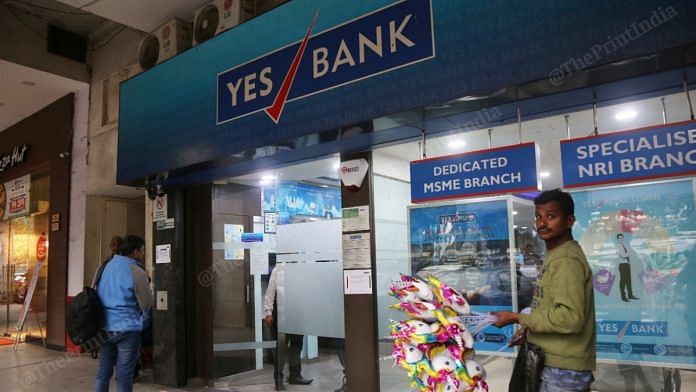New Delhi: The Reserve Bank of India placed Yes Bank, India’s fourth-largest private lender, under moratorium Thursday and capped deposit withdrawals, triggering widespread confusion and investor panic. The board of the bank, which was founded by Rana Kapoor and Ashok Kapur in 2003, was superseded amidst concerns of its weakening financial position.
After the central bank’s announcement, Yes Bank’s market capital nosedived to less than Rs 5,000 crore Friday from more than Rs 1 lakh crore in August 2018, with stocks plunging nearly 85 per cent.
This crisis, however, was a long time coming. The RBI had raised concerns over corporate governance lapses and the deteriorating quality of the bank’s loan books in the last few years. Here is a look at the chronology of events that led to the central bank’s decision:
1. Since its founding in 2003, Yes Bank rapidly expanded its corporate loan book by aggressively lending to corporates. Rana Kapoor, then-managing director and CEO, is known to be a risk taker, lending to even stressed companies.
2003
Rana Kapoor (with 2 Os) & Ashok Kapur (with an U) start Yes (not a no) Bank.
Kapoor is very aggressive while Kapur is conservative.
RBI likes Kapur but not Kapoor.
— Pratiksha Dake (@PratikshaDake) March 5, 2020
2. In 2008, co-founder Ashok Kapur was killed in the 26/11 terrorist attacks in Mumbai. After his death, Kapur’s wife Madhu and Rana Kapoor got embroiled in a legal battle, with the former seeking a say in the appointment of board directors. She won the case in 2015, with the Bombay High Court ruling that Madhu Kapur had the right to jointly appoint directors to the board with Rana Kapoor.
3. A report by UBS, a global financial services firm, flagged the rapid rise in Yes Bank’s loan book to stressed companies in 2015. The bank, displeased by the report, registered a complaint with SEBI against the firm.
4. Yes Bank’s stock hit an all-time high in August 2018. Market capitalisation crossed Rs one lakh crore. However, within a month, the bank informed the stock exchanges that RBI had given permission for Kapoor to continue as MD and CEO only till 31 January 2019. The board of the bank had recommended that Kapoor’s term be extended till August 2021. The stock price began falling as the board was asked to search for a new CEO.
Kapoor tweeted about his shares, likening them to diamonds.
Diamonds are Forever: My Promoter shares of @YESBANK are invaluable to me
— Rana Kapoor (@RanaKapoor_) September 28, 2018
I will eventually bequeath my @YESBANK Promoter shares to my 3 daughters and subsequently to their children, with a request in my Will stating not to sell a single share, as Diamonds are Forever!!
— Rana Kapoor (@RanaKapoor_) September 28, 2018
5. Chairman Ashok Chawla resigned in November 2018 after being named in a corruption chargesheet by CBI. This was closely followed by the resignation of an independent director, raising fresh concerns about the bank.
Rating agencies began downgrading debt instruments of the bank, citing potential impact of the resignations on capital-raising plans and the uncertainty around Kapoor’s successor.
6. Rana Kapoor stepped down in January 2019, Ajai Kumar was appointed interim CEO. Ravneet Gill was appointed the new CEO and took the reins on 1 March 2019.
7. In February 2019, the bank announced that a risk assessment report conducted by the Reserve Bank of India did not find any divergence in the recognition of bad debts. A day later, RBI pulled up the bank for selectively disclosing a confidential report. The regulator pointed out that the report had revealed several lapses and regulatory breaches in the bank’s functioning, and the selective disclosure by the bank was a deliberate attempt to mislead.
8. The bank faced a slew of fines from the RBI for the violation of various norms, which included non-compliance with the Swift system and prepaid instrument regulations, among others.
9. The April board meeting approved fundraising of up to $1 billion in one or more tranches. Fundraising became imperative as the bank reported a loss of Rs 1,507 crore on account of higher provisions in the fourth quarter of 2018-19.
10. Rana Kapoor pledged his entire 7.34 per cent stake against a loan, which led to the share price plunging. Kapoor started selling his shares and completely exited the bank by December 2019.
11. Yes Bank, under Gill, made several unsuccessful attempts to raise capital in the last few months. It only managed to raise $270 million in August and failed in all its subsequent attempts. Dodgy investors, continual downgrades and allegations of insider trading by a former board member all added to the bank’s woes, forcing the central bank to step in with a reconstruction plan.
Also read: I’m very much in India, Yes Bank founder Rana Kapoor says. But doesn’t react to RBI action




Kaash RBI ne achhe samay mein chronology samjhi hoti …
😂😂 good one